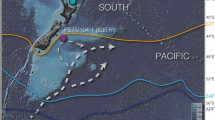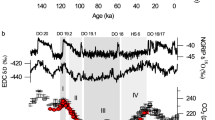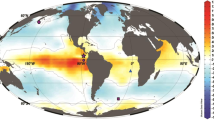Abstract
The Cretaceous Ocean Anoxic Event 2 (about 94 million years ago) is thought to be linked to extensive volcanism, which triggered a biogeochemical chain of events that eventually led to widespread marine anoxia and a remarkable increase in carbon burial in marine sediments1,2,3. It has been suggested that the event was accompanied by a substantial decrease in atmospheric CO2 concentrations4, but the quantification of the drawdown remains controversial5,6. Here we reconstruct atmospheric CO2 concentrations throughout the ocean anoxic event from counts of the stomata in fossil leaves, and use terrestrial carbon isotopes to link the reconstruction to marine records of the event7,8. We find that before the onset of ocean anoxia, atmospheric CO2 concentrations increased by 20% over background levels of 370+100/−70 ppm. This was part of a long-term rise in atmospheric CO2 levels, presumably caused by volcanism, which reached a peak of 500+400/−180 ppm. However, two pulses of extensive carbon burial during the ocean anoxic event, as indicated by positive carbon isotope excursions, are associated with decreased atmospheric CO2 concentrations. We conclude that the sequestration of marine organic carbon led to a decrease in atmospheric CO2 concentration of up to 26% during Ocean Anoxic Event 2.
This is a preview of subscription content, access via your institution
Access options
Subscribe to this journal
Receive 12 print issues and online access
$259.00 per year
only $21.58 per issue
Buy this article
- Purchase on Springer Link
- Instant access to full article PDF
Prices may be subject to local taxes which are calculated during checkout


Similar content being viewed by others
References
Kuroda, J. et al. Contemporaneous massive subaerial volcanism and Late Cretaceous Oceanic Anoxic Event 2. Earth Planet. Sci. Lett. 256, 211–223 (2007).
Frijia, G. & Parente, M. Strontium isotope stratigraphy in the upper Cenomanian shallow-water carbonates of the southern Apennines: Short-term perturbations of marine Sr-87/Sr-86 during the Oceanic Anoxic Event 2. Palaeogeogr. Palaeoclimatol. Palaeoecol. 261, 15–29 (2008).
Turgeon, S. C. & Creaser, R. A. Cretaceous Oceanic Anoxic Event 2 triggered by a massive magmatic episode. Nature 454, 323–329 (2008).
Arthur, M. A., Dean, W. E. & Pratt, L. M. Geochemical and climatic effects of increased marine organic carbon burial at the Cenomanian–Turonian boundary. Nature 335, 714–717 (1988).
Freeman, K. H. & Hayes, J. M. Fractionation of carbon isotopes by phytoplankton and estimates of ancient CO2 levels. Glob. Biogeochem. Cycles 6, 185–198 (1992).
Kuypers, M. M. M., Pancost, R. D. & Damste, J. S. S. A large and abrupt fall in atmospheric CO2 concentration during Cretaceous times. Nature 399, 342–345 (1999).
Laurin, J. & Sageman, B. Cenomanian–Turonian coastal record in SW Utah, USA: Orbital scale transgressive-regressive events during Oceanic Anoxic Event II. J. Sedim. Res. 77, 731–756 (2007).
Sageman, B. B., Meyers, S. R. & Arthur, M. A. Orbital timescale and new C-isotope record for Cenomanian–Turonian boundary stratotype. Geology 34, 125–128 (2006).
Leckie, R. M., Bralower, T. J. & Cashman, R. Oceanic anoxic events and plankton evolution: Biotic response to tectonic forcing during the mid-Cretaceous. Paleoceanography 17, 13.11–13.29 (2002).
Schlanger, S. O. & Jenkyns, H. C. Cretaceous oceanic anoxic events: Causes and consequences. Geol. Mijnb. 55, 179–184 (1976).
Tsikos, H. et al. Carbon-isotope stratigraphy recorded by the Cenomanian–Turonian Oceanic Anoxic Event: Correlation and implications based on three key localities. J. Geol. Soc. 161, 711–719 (2004).
Jenkyns, H. C., Gale, A. S. & Corfield, R. M. Carbon-isotope and oxygen-isotope stratigraphy of the English Chalk and Italian Scaglia and its paleoclimatic significance. Geol. Mag. 131, 1–34 (1994).
Woodward, F. I. Stomatal numbers are sensitive to increases in CO2 from preindustrial levels. Nature 327, 617–618 (1987).
Royer, D. L., Berner, R. A. & Beerling, D. J. Phanerozoic atmospheric CO2 change: Evaluating geochemical and paleobiological approaches. Earth Sci. Rev. 54, 349–392 (2001).
McElwain, J. C., Wade-Murphy, J. & Hesselbo, S. P. Changes in carbon dioxide during an oceanic anoxic event linked to intrusion into Gondwana coals. Nature 435, 479–482 (2005).
Elder, W. P., Gustason, E. R. & Sageman, B. B. Basinwide correlation of parasequences in the Greenhorn Cyclothem, Western Interior. Geol. Soc. Am. Bull. 106, 892–902 (1994).
Elder, W. P. Geometry of upper Cretaceous bentonite beds—implications about volcanic source areas and paleowind patterns, Western Interior, United-States. Geology 16, 835–838 (1988).
Hook, S. C. Contributions to mid-Cretaceous paleontology and stratigraphy of New Mexico—part II. New Mexico Bureau of Mines and Mineral Resources Circular 185 (1983).
Royer, D. L. et al. Paleobotanical evidence for near present-day levels of atmospheric CO2 during part of the Tertiary. Science 292, 2310–2313 (2001).
Kürschner, W. M., Kvaček, Z. & Dilcher, D. L. The impact of Miocene atmospheric carbon dioxide fluctuations on climate and the evolution of terrestrial ecosystems. Proc. Natl Acad. Sci. USA 105, 449–453 (2008).
Mort, H. P. et al. Phosphorus and the roles of productivity and nutrient recycling during Oceanic Anoxic Event 2. Geology 35, 483–486 (2007).
Gedney, N. et al. Detection of a direct carbon dioxide effect in continental river runoff records. Nature 439, 838–838 (2006).
Royer, D. L. CO2-forced climate thresholds during the Phanerozoic. Geochim. Cosmochim. Acta 70, 5665–5675 (2006).
Huber, B. T., Norris, R. D. & MacLeod, K. G. Deep-sea paleotemperature record of extreme warmth during the Cretaceous. Geology 30, 123–126 (2002).
Sinton, C. W. & Duncan, R. A. Potential links between ocean plateau volcanism and global ocean anoxia at the Cenomanian–Turonian boundary. Econ. Geol. 92, 836–842 (1997).
Gale, A. S. & Christensen, W. K. Occurrence of the belemnite Actinocamax plenus in the Cenomanian of SE France and its significance. Bull. Geol. Soc. Denmark 43, 68–77 (1996).
Forster, A., Schouten, S., Moriya, K., Wilson, P. A. & Damsté, J. S. S. Tropical warming and intermittent cooling during the Cenomanian/Turonian Oceanic Anoxic Event 2: Sea surface temperature records from the equatorial Atlantic. Paleoceanography 22, PA1219 (2007).
Quan, C., Sun, C., Sun, Y. & Sun, G. High resolution estimates of paleo-CO2 levels through the Campanian (Late Cretaceous) based on Ginkgo cuticles. Cretac. Res. 30, 424–428 (2009).
IPCC Climate Change 2007: The Physical Science Basis (eds Solomon, S. et al.) (Cambridge Univ. Press, 2007).
Uličný, D. Sequence stratigraphy of the Dakota Formation (Cenomanian), southern Utah: Interplay of eustasy and tectonics in a foreland basin. Sedimentology 46, 807–836 (1999).
Acknowledgements
Major financial support came from a National Science Foundation Grant (EAR0643290) to B.B.S. and J.C.M., a Marie Curie Excellence Grant (MEXT-CT-2006-042531) to J.C.M. and student grants to R.S.B. from the Geological Society of America, Evolving Earth Foundation, Colorado Science Society and Western Interior Paleontology Society, and the Paleontological Society Fieldwork assistance came from C. Carney, J. Laurin, J. Riser and K. Yedinak. Private land access was granted by P. Davis, BLM land by A. Titus and D. Powell (GSENM) and NPS land by J. Spence (Glen Canyon NRA). M. Hurtgen, J. Beard, K. Peeler, P. Sheaffova and P. McVary assisted with isotope analysis. G. R. Upchurch suggested H. zenkeri as a suitable modern analogue species; herbarium specimens were provided by The Field Museum and the Kew Herbarium (sampled by G. Giraud).
Author information
Authors and Affiliations
Contributions
R.S.B. was responsible for collection, processing and analysis of data, and was principal author of the manuscript. J.C.M. and B.B.S. designed the study, contributed equally in interpreting results and editing the manuscript, and gathering the principal financial support.
Corresponding author
Ethics declarations
Competing interests
The authors declare no competing financial interests.
Supplementary information
Supplementary Information
Supplementary Information (PDF 1427 kb)
Rights and permissions
About this article
Cite this article
Barclay, R., McElwain, J. & Sageman, B. Carbon sequestration activated by a volcanic CO2 pulse during Ocean Anoxic Event 2. Nature Geosci 3, 205–208 (2010). https://doi.org/10.1038/ngeo757
Received:
Accepted:
Published:
Issue Date:
DOI: https://doi.org/10.1038/ngeo757
This article is cited by
-
The Cenomanian/Turonian boundary in light of new developments in terrestrial palynology
Scientific Reports (2023)
-
Changes in macrofaunal groups before, during and after the Cenomanian–Turonian biotic crisis in north Eastern Desert, Egypt
Palaeobiodiversity and Palaeoenvironments (2023)
-
Calcium isotope ratios of malformed foraminifera reveal biocalcification stress preceded Oceanic Anoxic Event 2
Communications Earth & Environment (2022)
-
Marine organic carbon burial increased forest fire frequency during Oceanic Anoxic Event 2
Nature Geoscience (2020)
-
Coated grain petrography and geochemistry as palaeoenvironmental proxies for the Aptian strata of the southern Neo-Tethys Ocean, Persian Gulf, Iran
Facies (2020)



